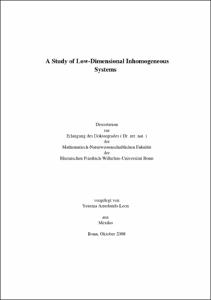Arredondo Leon, Yesenia: A Study of Low-Dimensional Inhomogeneous Systems. - Bonn, 2009. - Dissertation, Rheinische Friedrich-Wilhelms-Universität Bonn.
Online-Ausgabe in bonndoc: https://nbn-resolving.org/urn:nbn:de:hbz:5N-16579
Online-Ausgabe in bonndoc: https://nbn-resolving.org/urn:nbn:de:hbz:5N-16579
@phdthesis{handle:20.500.11811/4023,
urn: https://nbn-resolving.org/urn:nbn:de:hbz:5N-16579,
author = {{Yesenia Arredondo Leon}},
title = {A Study of Low-Dimensional Inhomogeneous Systems},
school = {Rheinische Friedrich-Wilhelms-Universität Bonn},
year = 2009,
month = jan,
note = {In the last decades there has been enormous progress in the fabrication of nanoscopic quasi-one-dimensional systems, e.g., carbon nanotubes, semiconducting quantum wires, and conducting organic molecules. These materials have an inhomogeneous composition due to defects, impurities, or because they are formed by several types of atoms. In such systems, the strong electron correlations, inherent to their low-dimensional structure, and large quantum fluctuations induce new and interesting quantum phases, for example superconductivity, quantum Hall edge states, and magnetic ordering.
While the properties of homogeneous one dimensional systems, even with disorder, are relatively well-understood, very little is known about the properties of strongly interacting inhomogeneous systems. Their high-energy physics is determined by the underlying chemistry which, in the atomic scale, introduces Coulomb correlations and local potentials. On the other hand, at large length scales, the physics has to be described by the Tomonaga- Luttinger liquid (TLL) model. In order to establish a connection between the low-energy TLL and the quasi-one-dimensional systems synthesized in the laboratory, we investigate the density-density correlation function in inhomogeneous one-dimensional systems in the asymptotic region. Position dependent on-site Coulomb interaction U(x) and local potentials V (x) are used to model the changes in the local chemistry of the inhomogeneous systems. To investigate homogeneous as well as inhomogeneous systems, we will use the density-matrix renormalization group (DMRG) method.
We will present results for ground state properties, such as the density-density correlation function and the parameter Kc, which characterizes its decay at large distances. Results on some dynamic properties such as spectral density and optical conductivity will be presented as well.},
url = {https://hdl.handle.net/20.500.11811/4023}
}
urn: https://nbn-resolving.org/urn:nbn:de:hbz:5N-16579,
author = {{Yesenia Arredondo Leon}},
title = {A Study of Low-Dimensional Inhomogeneous Systems},
school = {Rheinische Friedrich-Wilhelms-Universität Bonn},
year = 2009,
month = jan,
note = {In the last decades there has been enormous progress in the fabrication of nanoscopic quasi-one-dimensional systems, e.g., carbon nanotubes, semiconducting quantum wires, and conducting organic molecules. These materials have an inhomogeneous composition due to defects, impurities, or because they are formed by several types of atoms. In such systems, the strong electron correlations, inherent to their low-dimensional structure, and large quantum fluctuations induce new and interesting quantum phases, for example superconductivity, quantum Hall edge states, and magnetic ordering.
While the properties of homogeneous one dimensional systems, even with disorder, are relatively well-understood, very little is known about the properties of strongly interacting inhomogeneous systems. Their high-energy physics is determined by the underlying chemistry which, in the atomic scale, introduces Coulomb correlations and local potentials. On the other hand, at large length scales, the physics has to be described by the Tomonaga- Luttinger liquid (TLL) model. In order to establish a connection between the low-energy TLL and the quasi-one-dimensional systems synthesized in the laboratory, we investigate the density-density correlation function in inhomogeneous one-dimensional systems in the asymptotic region. Position dependent on-site Coulomb interaction U(x) and local potentials V (x) are used to model the changes in the local chemistry of the inhomogeneous systems. To investigate homogeneous as well as inhomogeneous systems, we will use the density-matrix renormalization group (DMRG) method.
We will present results for ground state properties, such as the density-density correlation function and the parameter Kc, which characterizes its decay at large distances. Results on some dynamic properties such as spectral density and optical conductivity will be presented as well.},
url = {https://hdl.handle.net/20.500.11811/4023}
}






